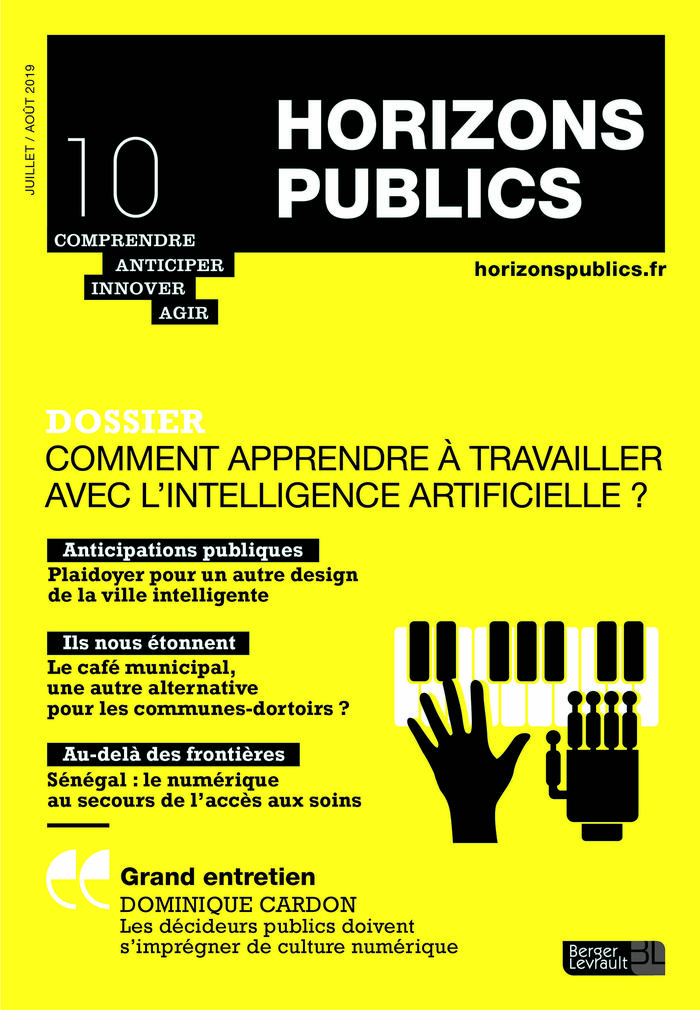Education and training: a brief evocation of issues related to "digital reality"
Summary
On the fundamental questions posed by digital technology to the educational institution, with regard, for example, to the personalization, diversification and adaptation of the contexts of learning, the evolution of the nature and processes of memorization, the evaluation of pupils, we do not always have benchmarks validated by science to support reflection and action. However, the stakes here are considerable, in particular with regard to the reduction of school failure and the facilitation of the success of the greatest number.
This is why digital technology must be understood and used in learning with the greatest scientific rigor in order to appreciate its interest and its limits. Without going into a specific analysis, it should however be pointed out that a number of questions related to this new situation are likely to generate both new scientific questions and new pedagogical practices.
Digital technology closer to teaching and learning
While the diffusion of digital technology appears to be an inevitable process that imposes itself on the educational institution and its actors, as well as on the rest of society, the real effects of this diffusion, in particular on the success pupils and the very conditions thereof, are not really known. The measurements carried out remain very partial and insignificant of the effectiveness of the transformations induced by digital technology. In addition, the prospects opened up by big data and analytics learning with the use of the analysis of learning data do not yet appear in the targets for new skills to be acquired by teachers, even though the major players digital worlds are in the process of making it an essential axis of their strategic development in the field of education. Also, schools cannot remain spectators of these transformations taking place before their eyes, especially since digital technology modifies not only access to knowledge but the development of knowledge itself. It is indeed undesirable to let digital technology take hold in education under the insistence and control of the big digital industrial leaders alone. Nor is it possible to rely on impressionistic evaluations to accompany the deployment of its educational uses.
While many actors in education are aware of the profound and irreversible changes that artificial intelligence (AI) is bringing about in the economy, work, health, culture, with its extensions in social relations and its intrusion into the space between the public and private spheres, their perception of the transformations of the School with the digital, still remains relatively uncertain. On the fundamental questions posed by digital technology to the educational institution, with regard, for example, to the personalization, diversification and adaptation of learning contexts, the evolution of the nature and processes of memorization, student assessment, we do not always have benchmarks validated by science to support reflection and action. However, the stakes here are considerable, in particular with regard to the reduction of school failure and the facilitation of the success of the greatest number.
This is why digital technology must be understood and used in learning with the greatest scientific rigor in order to appreciate its interest and its limits. Without going into a specific analysis, it should however be pointed out that a number of questions related to this new situation are likely to generate both new scientific questions and new pedagogical practices. The state of science today facilitates the mastery of a body of knowledge on learning, in particular on fundamental learning related to reading, counting, writing, language acquisition, for example. , which are able to effectively inform the innovative approaches supported by technological developments in teaching and learning1. Indeed, this scientific work, by bringing to light the mechanisms underlying learning, makes it possible to deduce pedagogical principles which can in turn be put into practice through, for example, educational games. Thus, in the form of “intelligent tools”, and based on the results of research, technology can be put at the service of education. A technology that is more and more present in the educational space2. This is why pedagogical innovations must relate less to its characteristics in themselves than to the ability to use it and enslave it as a means for the purpose of optimizing learning and teaching.
Thus, for example, the technological ability to offer multiple media and contexts for the presentation of information for its processing by students opens up remarkable prospects for increasing the probability of its access by as many people as possible. . Indeed, a mono-contextual approach to information distances those who are less familiar with the “vehicular culture” and places them in a situation of “cognitive overload” likely to lead to premature dropout. The personalization of teaching and learning can find there one of its means of realization.
The convergence of many works, carried out in the field of cognition and its "social determinants", makes it possible to indicate that the effective processing of information requires the mobilization of a quantity of attention of all the more important as the task is complex and unfamiliar. It will also be understood that everything that contributes to reducing the cost of attention, linked to the environment or the context of the task, contributes to the quality and therefore to the efficiency of its processing. It is, moreover, quite easy to agree on the fact that students do not necessarily have the same familiarity with the context in which the task or problem to be solved are presented, nor the same learning profile. These differences can then generate variable "attentional costs" for processing the context and thus cause serious inequalities in performance, which would therefore be less due to the intrinsic cognitive skills of individuals than to their lack of familiarity with the context in which the task is presented or with the information processing modality proposed3.
Also, we cannot rule out the hypothesis that there are here the first elements of a failure unrelated to any "intellectual" limit linked to the complexity of "the problem" to be dealt with, but only in connection with a "dressing" or a presentation more or less distant from the environments familiar to the pupils concerned. This is why the possibilities offered, in the context of AI, by digital technologies, which make it possible to present the information or the problems to be solved in various forms, constitute so many opportunities to make access to their treatment. Without venturing into a prediction of the reduction of certain school failures in connection with this type of use alone, we can nevertheless underline its heuristic interest. This is one of the reasons why, in the e-Fran4 programme, winning scientific consortia are experimenting with new ways of teaching and learning, using innovative pedagogical and digital devices. The stated objective is part of an enrichment of the teacher's response keyboard to increase his creativity and his freedom as a practitioner. Teach computational thinking in relation to mathematics, diversify learning contexts in an intelligent tutoring system, promote collaborative learning through tangible and augmented interfaces, experiment with the project-based approach through 3D design, develop and test a open source software for playful learning of fundamentals in kindergarten, these are some projects that illustrate the scientific field covered by the work undertaken within the framework of e-Fran. Thus, it is a question of guiding high-level research teams on the fundamental issues of digital education and ensuring, thereafter, the dissemination of the results and their use in the initial and continuous training of all actors in education and particularly in the context of teacher training.

A supra-ordering objective then becomes that of linking teaching and learning practices to the products and insights of research. Such an objective necessarily presupposes close cooperation between the various actors involved in order to make the link between upstream research and downstream achievements based on an anchor, which can be assessed and lasted, in the practices, scientific results and syntheses which make it possible to appreciate its scope5.
Engaging the School in the transformation of society through and with digital technology
While converging studies6 show that a significant percentage of jobs will be affected by automation in the next ten years, knowledge of the scope of these transformations and the concomitant adaptation of the training that prepares for it is essential today. If new jobs will indeed be created, we do not know today either the nature or the characteristics, so it is essential to adapt vocational training so that it can prepare for the acquisition of new skills likely to be solicited for these jobs.
Min req for dating me... you gotta know how to change a tire and oil ....u also need to know how to grill and season meat...
— Ms. unapologetic Fri May 31 00:12:23 +0000 2019
This ongoing process questions the relevance of our training system and its ability to adapt to the new situation in the digital age. Beyond the technical skills required by technological developments, it is a question of promoting the development of skills that are difficult to automate, such as relational and organizational skills or even individual and collective creativity. Therefore, upstream of vocational training, education and initial training must integrate these new requirements.
In education and training, the lack of dialogue between education practitioners, researchers and the economic world too often hinders the consideration of each other's needs and limits opportunities for collaboration , to the detriment of relevant and effective understanding of digital-related transformations in education and training. It is therefore necessary to promote new approaches to launch initiatives whose transversality meets the needs shared by the diversity of actors in education and training.
It is also a question of defining the nature and the methods of acquisition of these new skills which will condition professional mastery and versatility at work in the "digital society". This is why, also initiated within the framework of the PIA2, the ProFan project that we are leading involves several research laboratories and endeavors to nurture a new "skills kit" for use by students in vocational education, the first concerned with the automation of tasks which until then constituted their professional daily life when they entered the world of work.
Strongly backed by research of the highest level, this project aims to scientifically test teaching and learning methods likely to generate new skills, made necessary by changes in the organization of work linked to the intrusion digital technology in management and production processes, whatever their nature. In this perspective, experimentation carried out on a large scale makes it possible to test, qualify and evaluate the conditions for developing new skills which, it is hypothesized, will constitute a basic foundation for all professional activities and therefore also for those attached to the lowest levels of qualification. This is why it is useful to demonstrate that in the presence of a change in the economic and behavioral paradigm, it is possible to promote a training framework that is increased and fed by new forms of work linked to the presence of digital technology. This, by addressing electively those who are usually denied, and much too spontaneously and easily, to be “cognitive workers”.
Engaged at the very base of the professional hierarchy of trades, this new ergonomic deal can provide the foundations of an ambition to deal with the paradigm shift that we are witnessing in dimensions linked, in particular, to collective and collaborative intelligence. and the presence of artificial intelligence. An ambition that demands, and will demand, that work organizations be part of the complex management of new professional exercises in new situations, most often breaking with the usual verticalities at work in productive and educational spaces. Thus, lifelong learning will become the norm. But the quality of this permanence will depend on the creativity and efficiency of productive organizations. However, one and the other, creativity and efficiency, are not possible, in an ecosystem oriented and defined, even constrained, by the technological mosaic (big data, robotization, simulation, additive manufacturing, Internet of things, augmented reality, etc.) only if the skills of social intelligence, autonomy, taking initiative and cognitive apprehension of the operations to be carried out are shared by the professional actors within the workspaces.
The evocation of these elements necessarily leads to consider initial and continuing training from a new angle: that of multi-level learning. Indeed, how to deal with collective intelligence, collaboration7, autonomy, if a common basis of representations does not structure the operations of each other while they evolve in professional universes radically transformed? In these universes, the work is no longer segmented upstream, as in the Taylorian model, but versatile, integrated and accomplished in often unprecedented situations. Moreover, its organization, by significantly inflecting the usual verticalities, promotes more horizontal and reticular approaches.
This is why it is a good idea to acquire new methods of thinking, working and organizing. Therefore, design, production and collaboration, in particular, must be installed at the heart of the training systems that must be promoted. It is no longer the only quality of the gesture in and for the production that prevails, but the processing of information and the representation upstream of the very act of “doing”.
If for National Education the stake is major, the same goes for the ability of our society and our economy to meet the challenges of the future in international spaces that are open and competitive but increasingly weakly predictable. . The training approach, in its procedural aspects and no longer just factual, is therefore part of a process of transformation which must lead to a reactive and cognitively agile organizational capacity, nourished by the permanent observation of behaviors related to professional exercises. and their evolution in relation to “digital worlds” where the interactions between “artificial and natural intelligences” are increasingly dense. It is a question of responding, beyond the academic culture consubstantial with our educational, scientific and cultural history, to the new requirements for sharing new skills to generate "acting together", made essential by professional practices and the training of increasingly interdependent.
Permanent learning, at the very center of such an approach, must lead to “continuing education” being part of an anticipatory and no longer restorative, offensive and no longer defensive approach. Thus, in addition to the acquisition of the usual formal skills attached to the profession, non-formal skills will be added to promote new ways of exercising it. These non-formal skills, accessible today primarily to those with the highest qualifications, will have to be more widely shared, enriched and “scientifically structured” to correspond to the new work requirements. By reassessing the educational ambition, the paradigm shift linked to digital is naturally at the heart of the logic of social transformation.
Obviously, the increasing number of interactions between the professional world and the personal world will mean that what is acquired in one will also apply to the other. With the aim of promoting everyone's potential on a general basis, we cannot therefore stay out of these approaches which aim to reconcile, if not to reconcile, professional future and personal development.
Making the digital world intelligible and controllable by as many people as possible becomes a requirement for education and training, both initial and ongoing, to make our behavior not only responses adapted to the demands of our technological environment, but also responses that translate our capacities to produce a creative excess of it as well as to ward off its negative effects.
Such a requirement calls for increased participation of the world of research in ordinary life, not of course for its science tunic, but to promote for each of us and among educators and trainers a more enlightened commitment than that to which the current mores of social exchange lead us, which sometimes make acceptable what may otherwise be false.
This is why, at a time when "new intelligence technologies" are shaking up our lives and the representation we have of them, education and training must be able to partly grasp their interests, limits and stakes to put them at the service of the objectives of social and cognitive autonomy that they pursue.
- Dehaene S., The math bump fifteen years later, 2010, Odile Jacob; Dehaene S., Dehaene-Lambertz G., Huron C. and Sprenger-Charolles L., Learning to read. From cognitive sciences to the classroom, 2011, Odile Jacob; Dehaene S., Learning! The talents of the brain, the challenge of machines, 2018, Odile Jacob.
- Escueta M., Quan. V., Nickow A. J. and Oreopoulos P., “Education Technology: An Evidence-Based Review”, NBER Working Paper 2017, no 23744.
- Huguet P., Brunot S . and Monteil J.-M., “Geometry versus drawing: Changing the meaning of the task as a means to change performance”, Social Psychology of Education 2001, p. 219–234; Monteil J.M. and Huguet P., “Social Context and Cognitive Performance: Toward a Social Psychology of Cognition, Hove”, Psychology Press 1999; “The social regulation of Classroom Performances: A theoretical outline”, Social Psychology of Education 2001, p. 359-372; Succeed or fail at school: a question of context?, 2013, Grenoble University Press; Monteil J.-M., Brunot S. and Huguet P., “Cognitive performance and attention in the classroom: An interaction between past and present academic experiences”, Journal of Educational Psychology 1996, no 88 , p. 242-248.
- Program that we are conducting as part of the future investment program (PIA2) within the interministerial Digital and Education mission.
- Cheung A. C. K., Slavin R.E., “Effects of Educational Technology Applications on Reading Outcomes for Struggling Readers: A Best-Evidence Synthesis”, Reading Research Quarterly 2013, no 48, p. 277–299; “The effectiveness of educational technology applications for enhancing mathematics achievement in K-12 classrooms: A meta-analysis”, Educational Research Review 2013, no 9, p. 88–113; Leroux G., Monteil J.-M. and Huguet P., "School learning and digital technologies: a critical review of meta-analyses" L'Année Psychologique/Topics in Cognitive Psychology 2017, no 117, p. 433-465.
- Employment Guidance Council, “Automation, Digitization and Employment,” 2017.
- Johnson D.W. and Johnson R.T., “An Educational Psychology Success Story: Social Interdependence Theory and Cooperative Learning”, Educational Researcher 2009, no 38, p. 365–379.










10 Ways to Stay Safe When You Live Alone
Hotels, restaurants: tips paid by credit card will soon be tax-exempt
"I was a rot in the evening and a good cop in the morning": meeting with "Haurus", the thug policeman of the DGSI
Will Belgian workers quit?